Analysis of Organizational Effectiveness: Westpac Australia Report
VerifiedAdded on 2022/08/21
|6
|1445
|11
Report
AI Summary
This report examines the organizational effectiveness of Westpac Australia, addressing its purpose, scope of operations, and strategic planning. The analysis includes an evaluation of effectiveness criteria from the author's perspective and those of different stakeholder groups, such as creditors and employees. The report emphasizes the importance of strategic planning as a key criterion for Westpac's success, particularly in the context of the financial sector and its associated risks. It explores how strategic planning can aid in risk reduction and the development of a coherent approach to organizational effectiveness. The report also discusses the implications of a coherent approach, focusing on value management and customer orientation to achieve sustainable shareholder value and operational success. The conclusion highlights the significance of customer-centric strategies and well-established plans for ensuring Westpac's continued effectiveness and success.
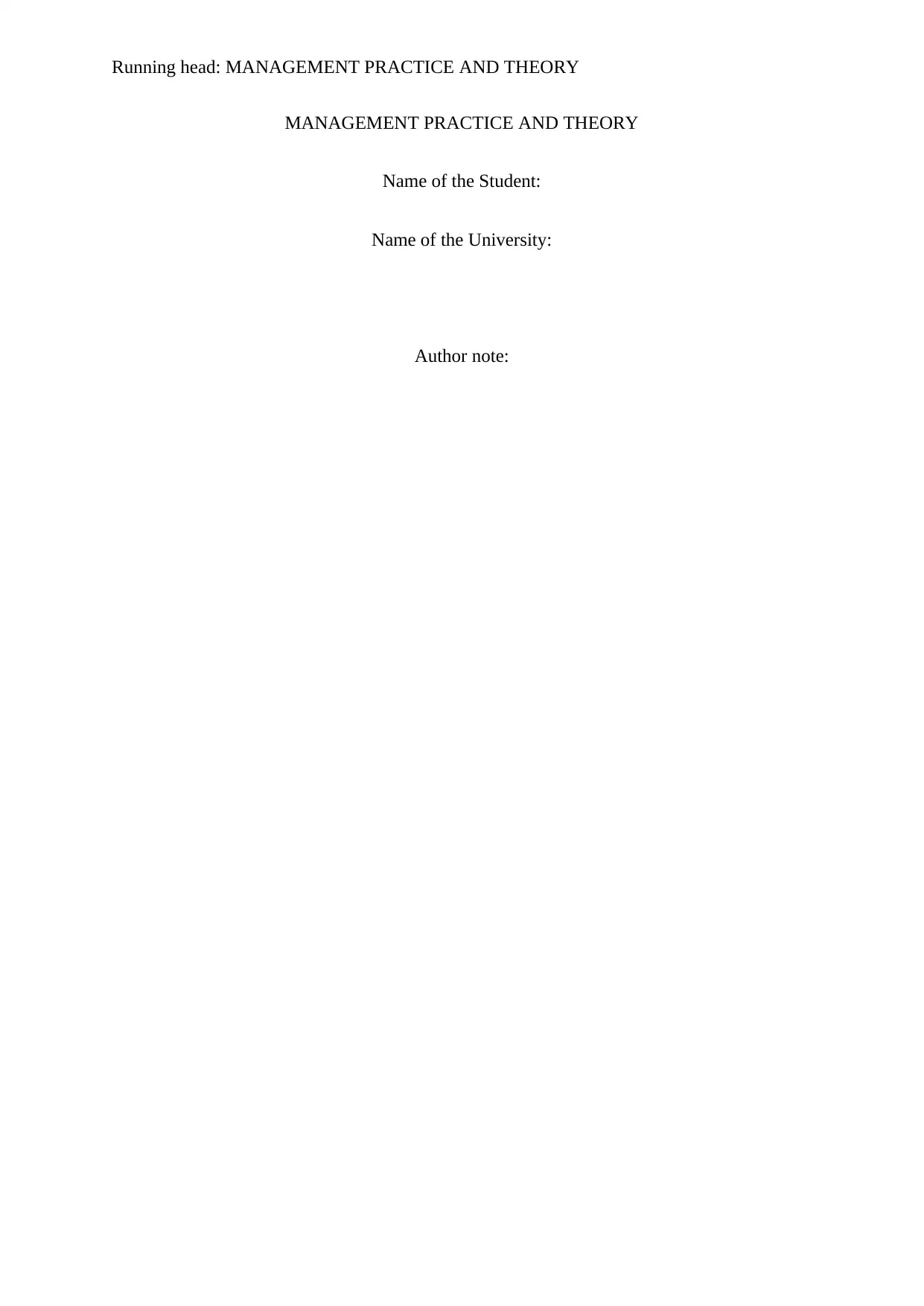
Running head: MANAGEMENT PRACTICE AND THEORY
MANAGEMENT PRACTICE AND THEORY
Name of the Student:
Name of the University:
Author note:
MANAGEMENT PRACTICE AND THEORY
Name of the Student:
Name of the University:
Author note:
Paraphrase This Document
Need a fresh take? Get an instant paraphrase of this document with our AI Paraphraser
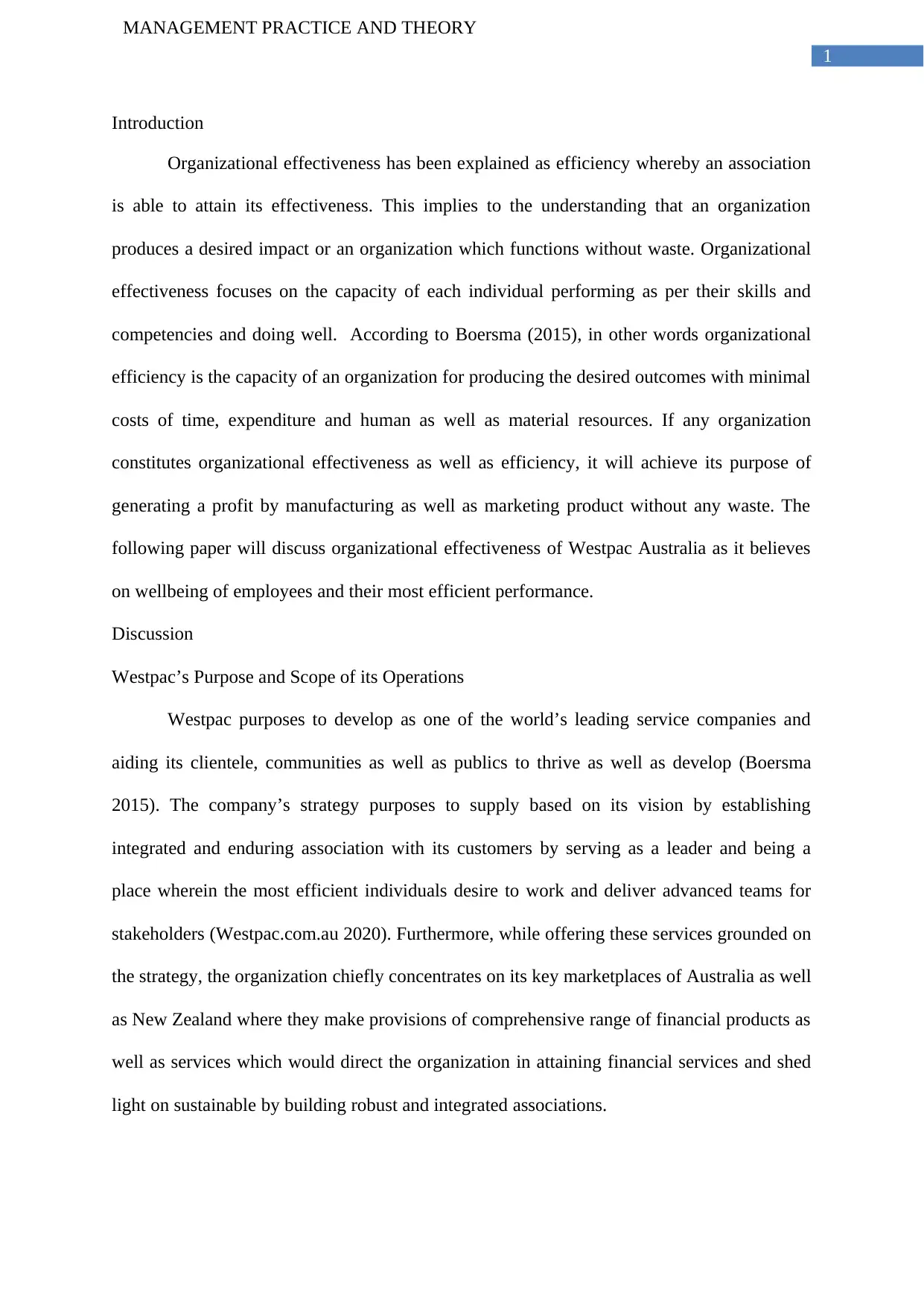
1
MANAGEMENT PRACTICE AND THEORY
Introduction
Organizational effectiveness has been explained as efficiency whereby an association
is able to attain its effectiveness. This implies to the understanding that an organization
produces a desired impact or an organization which functions without waste. Organizational
effectiveness focuses on the capacity of each individual performing as per their skills and
competencies and doing well. According to Boersma (2015), in other words organizational
efficiency is the capacity of an organization for producing the desired outcomes with minimal
costs of time, expenditure and human as well as material resources. If any organization
constitutes organizational effectiveness as well as efficiency, it will achieve its purpose of
generating a profit by manufacturing as well as marketing product without any waste. The
following paper will discuss organizational effectiveness of Westpac Australia as it believes
on wellbeing of employees and their most efficient performance.
Discussion
Westpac’s Purpose and Scope of its Operations
Westpac purposes to develop as one of the world’s leading service companies and
aiding its clientele, communities as well as publics to thrive as well as develop (Boersma
2015). The company’s strategy purposes to supply based on its vision by establishing
integrated and enduring association with its customers by serving as a leader and being a
place wherein the most efficient individuals desire to work and deliver advanced teams for
stakeholders (Westpac.com.au 2020). Furthermore, while offering these services grounded on
the strategy, the organization chiefly concentrates on its key marketplaces of Australia as well
as New Zealand where they make provisions of comprehensive range of financial products as
well as services which would direct the organization in attaining financial services and shed
light on sustainable by building robust and integrated associations.
MANAGEMENT PRACTICE AND THEORY
Introduction
Organizational effectiveness has been explained as efficiency whereby an association
is able to attain its effectiveness. This implies to the understanding that an organization
produces a desired impact or an organization which functions without waste. Organizational
effectiveness focuses on the capacity of each individual performing as per their skills and
competencies and doing well. According to Boersma (2015), in other words organizational
efficiency is the capacity of an organization for producing the desired outcomes with minimal
costs of time, expenditure and human as well as material resources. If any organization
constitutes organizational effectiveness as well as efficiency, it will achieve its purpose of
generating a profit by manufacturing as well as marketing product without any waste. The
following paper will discuss organizational effectiveness of Westpac Australia as it believes
on wellbeing of employees and their most efficient performance.
Discussion
Westpac’s Purpose and Scope of its Operations
Westpac purposes to develop as one of the world’s leading service companies and
aiding its clientele, communities as well as publics to thrive as well as develop (Boersma
2015). The company’s strategy purposes to supply based on its vision by establishing
integrated and enduring association with its customers by serving as a leader and being a
place wherein the most efficient individuals desire to work and deliver advanced teams for
stakeholders (Westpac.com.au 2020). Furthermore, while offering these services grounded on
the strategy, the organization chiefly concentrates on its key marketplaces of Australia as well
as New Zealand where they make provisions of comprehensive range of financial products as
well as services which would direct the organization in attaining financial services and shed
light on sustainable by building robust and integrated associations.
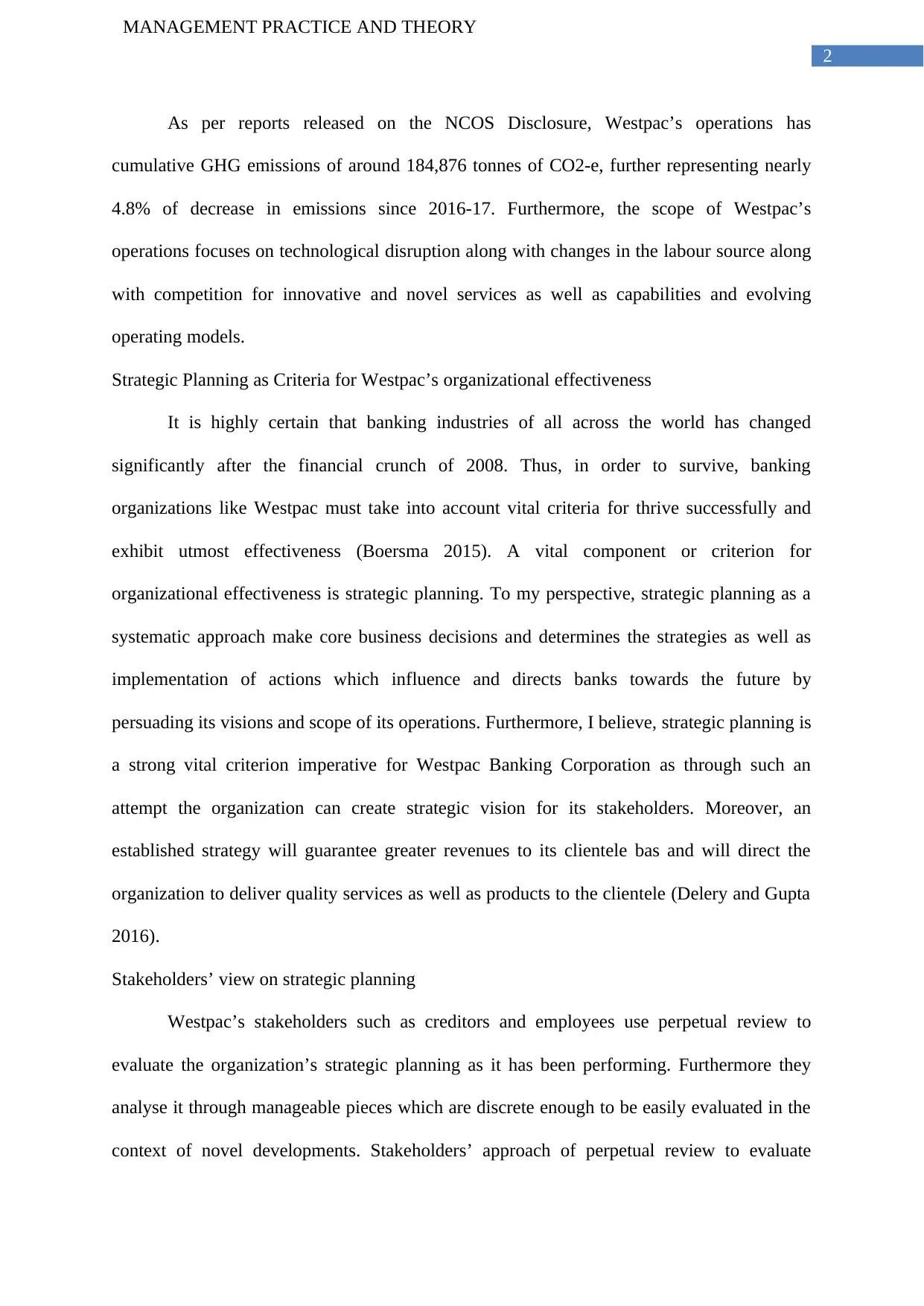
2
MANAGEMENT PRACTICE AND THEORY
As per reports released on the NCOS Disclosure, Westpac’s operations has
cumulative GHG emissions of around 184,876 tonnes of CO2-e, further representing nearly
4.8% of decrease in emissions since 2016-17. Furthermore, the scope of Westpac’s
operations focuses on technological disruption along with changes in the labour source along
with competition for innovative and novel services as well as capabilities and evolving
operating models.
Strategic Planning as Criteria for Westpac’s organizational effectiveness
It is highly certain that banking industries of all across the world has changed
significantly after the financial crunch of 2008. Thus, in order to survive, banking
organizations like Westpac must take into account vital criteria for thrive successfully and
exhibit utmost effectiveness (Boersma 2015). A vital component or criterion for
organizational effectiveness is strategic planning. To my perspective, strategic planning as a
systematic approach make core business decisions and determines the strategies as well as
implementation of actions which influence and directs banks towards the future by
persuading its visions and scope of its operations. Furthermore, I believe, strategic planning is
a strong vital criterion imperative for Westpac Banking Corporation as through such an
attempt the organization can create strategic vision for its stakeholders. Moreover, an
established strategy will guarantee greater revenues to its clientele bas and will direct the
organization to deliver quality services as well as products to the clientele (Delery and Gupta
2016).
Stakeholders’ view on strategic planning
Westpac’s stakeholders such as creditors and employees use perpetual review to
evaluate the organization’s strategic planning as it has been performing. Furthermore they
analyse it through manageable pieces which are discrete enough to be easily evaluated in the
context of novel developments. Stakeholders’ approach of perpetual review to evaluate
MANAGEMENT PRACTICE AND THEORY
As per reports released on the NCOS Disclosure, Westpac’s operations has
cumulative GHG emissions of around 184,876 tonnes of CO2-e, further representing nearly
4.8% of decrease in emissions since 2016-17. Furthermore, the scope of Westpac’s
operations focuses on technological disruption along with changes in the labour source along
with competition for innovative and novel services as well as capabilities and evolving
operating models.
Strategic Planning as Criteria for Westpac’s organizational effectiveness
It is highly certain that banking industries of all across the world has changed
significantly after the financial crunch of 2008. Thus, in order to survive, banking
organizations like Westpac must take into account vital criteria for thrive successfully and
exhibit utmost effectiveness (Boersma 2015). A vital component or criterion for
organizational effectiveness is strategic planning. To my perspective, strategic planning as a
systematic approach make core business decisions and determines the strategies as well as
implementation of actions which influence and directs banks towards the future by
persuading its visions and scope of its operations. Furthermore, I believe, strategic planning is
a strong vital criterion imperative for Westpac Banking Corporation as through such an
attempt the organization can create strategic vision for its stakeholders. Moreover, an
established strategy will guarantee greater revenues to its clientele bas and will direct the
organization to deliver quality services as well as products to the clientele (Delery and Gupta
2016).
Stakeholders’ view on strategic planning
Westpac’s stakeholders such as creditors and employees use perpetual review to
evaluate the organization’s strategic planning as it has been performing. Furthermore they
analyse it through manageable pieces which are discrete enough to be easily evaluated in the
context of novel developments. Stakeholders’ approach of perpetual review to evaluate
⊘ This is a preview!⊘
Do you want full access?
Subscribe today to unlock all pages.

Trusted by 1+ million students worldwide
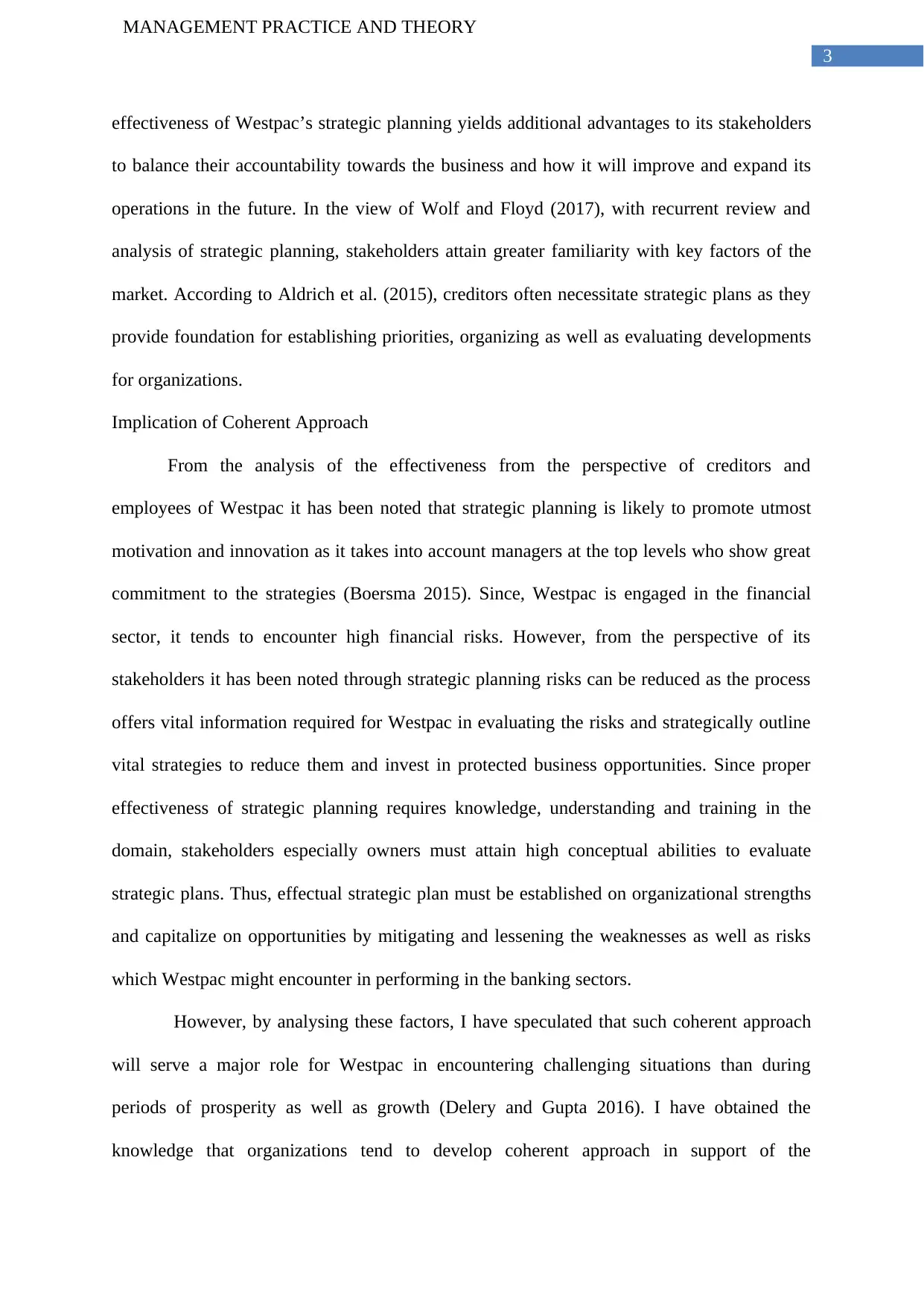
3
MANAGEMENT PRACTICE AND THEORY
effectiveness of Westpac’s strategic planning yields additional advantages to its stakeholders
to balance their accountability towards the business and how it will improve and expand its
operations in the future. In the view of Wolf and Floyd (2017), with recurrent review and
analysis of strategic planning, stakeholders attain greater familiarity with key factors of the
market. According to Aldrich et al. (2015), creditors often necessitate strategic plans as they
provide foundation for establishing priorities, organizing as well as evaluating developments
for organizations.
Implication of Coherent Approach
From the analysis of the effectiveness from the perspective of creditors and
employees of Westpac it has been noted that strategic planning is likely to promote utmost
motivation and innovation as it takes into account managers at the top levels who show great
commitment to the strategies (Boersma 2015). Since, Westpac is engaged in the financial
sector, it tends to encounter high financial risks. However, from the perspective of its
stakeholders it has been noted through strategic planning risks can be reduced as the process
offers vital information required for Westpac in evaluating the risks and strategically outline
vital strategies to reduce them and invest in protected business opportunities. Since proper
effectiveness of strategic planning requires knowledge, understanding and training in the
domain, stakeholders especially owners must attain high conceptual abilities to evaluate
strategic plans. Thus, effectual strategic plan must be established on organizational strengths
and capitalize on opportunities by mitigating and lessening the weaknesses as well as risks
which Westpac might encounter in performing in the banking sectors.
However, by analysing these factors, I have speculated that such coherent approach
will serve a major role for Westpac in encountering challenging situations than during
periods of prosperity as well as growth (Delery and Gupta 2016). I have obtained the
knowledge that organizations tend to develop coherent approach in support of the
MANAGEMENT PRACTICE AND THEORY
effectiveness of Westpac’s strategic planning yields additional advantages to its stakeholders
to balance their accountability towards the business and how it will improve and expand its
operations in the future. In the view of Wolf and Floyd (2017), with recurrent review and
analysis of strategic planning, stakeholders attain greater familiarity with key factors of the
market. According to Aldrich et al. (2015), creditors often necessitate strategic plans as they
provide foundation for establishing priorities, organizing as well as evaluating developments
for organizations.
Implication of Coherent Approach
From the analysis of the effectiveness from the perspective of creditors and
employees of Westpac it has been noted that strategic planning is likely to promote utmost
motivation and innovation as it takes into account managers at the top levels who show great
commitment to the strategies (Boersma 2015). Since, Westpac is engaged in the financial
sector, it tends to encounter high financial risks. However, from the perspective of its
stakeholders it has been noted through strategic planning risks can be reduced as the process
offers vital information required for Westpac in evaluating the risks and strategically outline
vital strategies to reduce them and invest in protected business opportunities. Since proper
effectiveness of strategic planning requires knowledge, understanding and training in the
domain, stakeholders especially owners must attain high conceptual abilities to evaluate
strategic plans. Thus, effectual strategic plan must be established on organizational strengths
and capitalize on opportunities by mitigating and lessening the weaknesses as well as risks
which Westpac might encounter in performing in the banking sectors.
However, by analysing these factors, I have speculated that such coherent approach
will serve a major role for Westpac in encountering challenging situations than during
periods of prosperity as well as growth (Delery and Gupta 2016). I have obtained the
knowledge that organizations tend to develop coherent approach in support of the
Paraphrase This Document
Need a fresh take? Get an instant paraphrase of this document with our AI Paraphraser
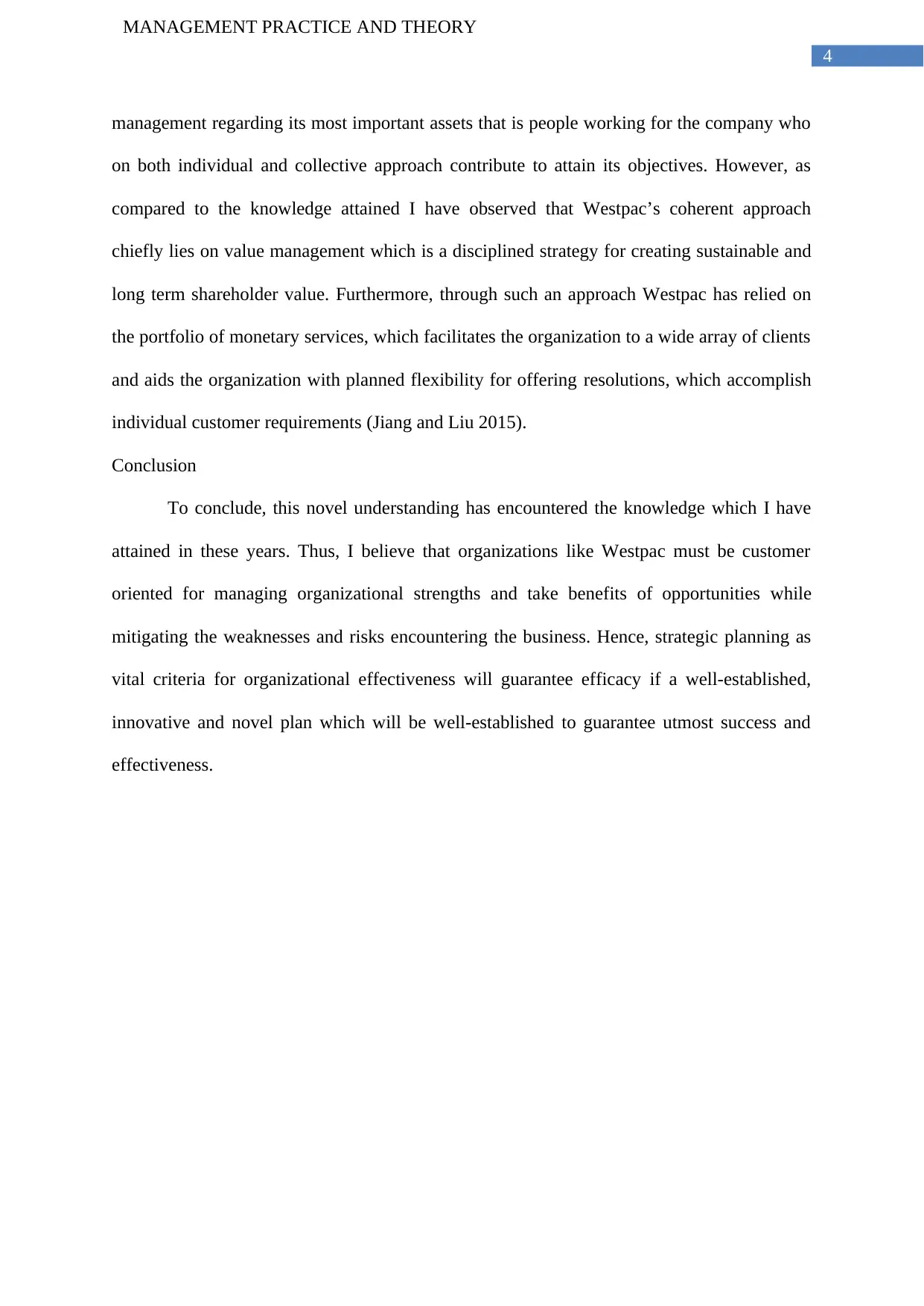
4
MANAGEMENT PRACTICE AND THEORY
management regarding its most important assets that is people working for the company who
on both individual and collective approach contribute to attain its objectives. However, as
compared to the knowledge attained I have observed that Westpac’s coherent approach
chiefly lies on value management which is a disciplined strategy for creating sustainable and
long term shareholder value. Furthermore, through such an approach Westpac has relied on
the portfolio of monetary services, which facilitates the organization to a wide array of clients
and aids the organization with planned flexibility for offering resolutions, which accomplish
individual customer requirements (Jiang and Liu 2015).
Conclusion
To conclude, this novel understanding has encountered the knowledge which I have
attained in these years. Thus, I believe that organizations like Westpac must be customer
oriented for managing organizational strengths and take benefits of opportunities while
mitigating the weaknesses and risks encountering the business. Hence, strategic planning as
vital criteria for organizational effectiveness will guarantee efficacy if a well-established,
innovative and novel plan which will be well-established to guarantee utmost success and
effectiveness.
MANAGEMENT PRACTICE AND THEORY
management regarding its most important assets that is people working for the company who
on both individual and collective approach contribute to attain its objectives. However, as
compared to the knowledge attained I have observed that Westpac’s coherent approach
chiefly lies on value management which is a disciplined strategy for creating sustainable and
long term shareholder value. Furthermore, through such an approach Westpac has relied on
the portfolio of monetary services, which facilitates the organization to a wide array of clients
and aids the organization with planned flexibility for offering resolutions, which accomplish
individual customer requirements (Jiang and Liu 2015).
Conclusion
To conclude, this novel understanding has encountered the knowledge which I have
attained in these years. Thus, I believe that organizations like Westpac must be customer
oriented for managing organizational strengths and take benefits of opportunities while
mitigating the weaknesses and risks encountering the business. Hence, strategic planning as
vital criteria for organizational effectiveness will guarantee efficacy if a well-established,
innovative and novel plan which will be well-established to guarantee utmost success and
effectiveness.
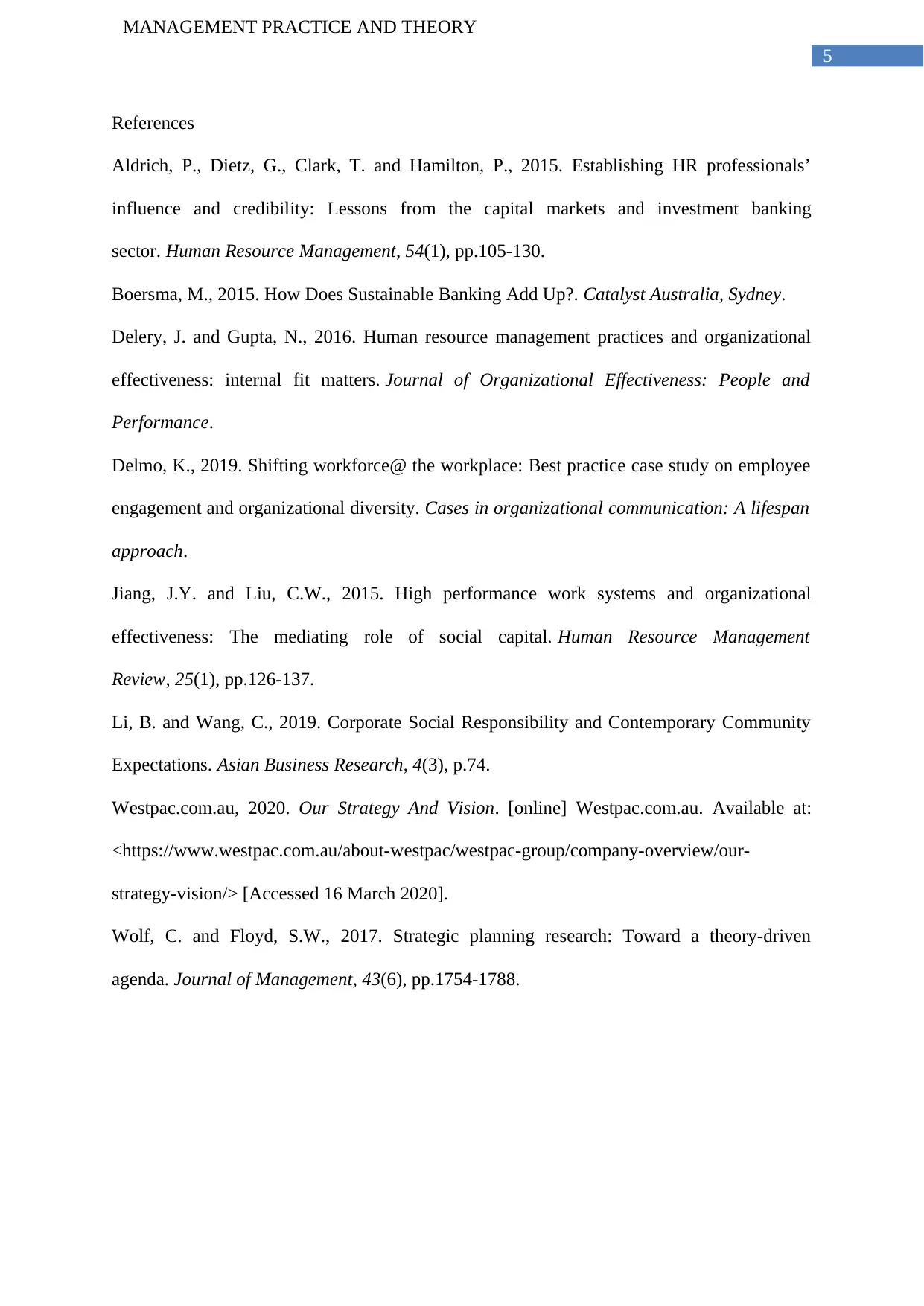
5
MANAGEMENT PRACTICE AND THEORY
References
Aldrich, P., Dietz, G., Clark, T. and Hamilton, P., 2015. Establishing HR professionals’
influence and credibility: Lessons from the capital markets and investment banking
sector. Human Resource Management, 54(1), pp.105-130.
Boersma, M., 2015. How Does Sustainable Banking Add Up?. Catalyst Australia, Sydney.
Delery, J. and Gupta, N., 2016. Human resource management practices and organizational
effectiveness: internal fit matters. Journal of Organizational Effectiveness: People and
Performance.
Delmo, K., 2019. Shifting workforce@ the workplace: Best practice case study on employee
engagement and organizational diversity. Cases in organizational communication: A lifespan
approach.
Jiang, J.Y. and Liu, C.W., 2015. High performance work systems and organizational
effectiveness: The mediating role of social capital. Human Resource Management
Review, 25(1), pp.126-137.
Li, B. and Wang, C., 2019. Corporate Social Responsibility and Contemporary Community
Expectations. Asian Business Research, 4(3), p.74.
Westpac.com.au, 2020. Our Strategy And Vision. [online] Westpac.com.au. Available at:
<https://www.westpac.com.au/about-westpac/westpac-group/company-overview/our-
strategy-vision/> [Accessed 16 March 2020].
Wolf, C. and Floyd, S.W., 2017. Strategic planning research: Toward a theory-driven
agenda. Journal of Management, 43(6), pp.1754-1788.
MANAGEMENT PRACTICE AND THEORY
References
Aldrich, P., Dietz, G., Clark, T. and Hamilton, P., 2015. Establishing HR professionals’
influence and credibility: Lessons from the capital markets and investment banking
sector. Human Resource Management, 54(1), pp.105-130.
Boersma, M., 2015. How Does Sustainable Banking Add Up?. Catalyst Australia, Sydney.
Delery, J. and Gupta, N., 2016. Human resource management practices and organizational
effectiveness: internal fit matters. Journal of Organizational Effectiveness: People and
Performance.
Delmo, K., 2019. Shifting workforce@ the workplace: Best practice case study on employee
engagement and organizational diversity. Cases in organizational communication: A lifespan
approach.
Jiang, J.Y. and Liu, C.W., 2015. High performance work systems and organizational
effectiveness: The mediating role of social capital. Human Resource Management
Review, 25(1), pp.126-137.
Li, B. and Wang, C., 2019. Corporate Social Responsibility and Contemporary Community
Expectations. Asian Business Research, 4(3), p.74.
Westpac.com.au, 2020. Our Strategy And Vision. [online] Westpac.com.au. Available at:
<https://www.westpac.com.au/about-westpac/westpac-group/company-overview/our-
strategy-vision/> [Accessed 16 March 2020].
Wolf, C. and Floyd, S.W., 2017. Strategic planning research: Toward a theory-driven
agenda. Journal of Management, 43(6), pp.1754-1788.
⊘ This is a preview!⊘
Do you want full access?
Subscribe today to unlock all pages.

Trusted by 1+ million students worldwide
1 out of 6
Related Documents
Your All-in-One AI-Powered Toolkit for Academic Success.
+13062052269
info@desklib.com
Available 24*7 on WhatsApp / Email
![[object Object]](/_next/static/media/star-bottom.7253800d.svg)
Unlock your academic potential
Copyright © 2020–2025 A2Z Services. All Rights Reserved. Developed and managed by ZUCOL.





